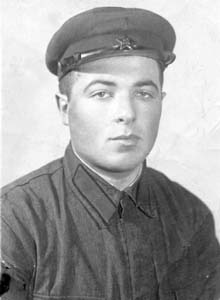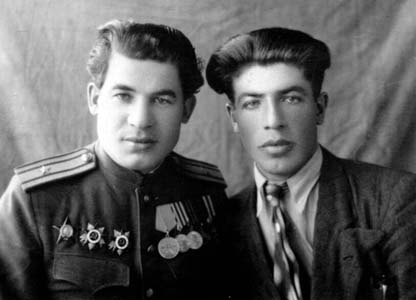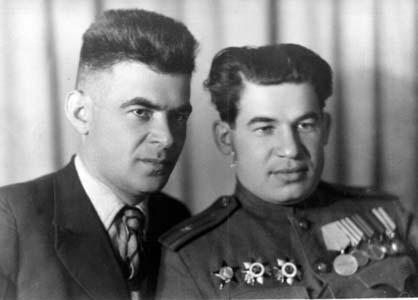

Project «Voices of Jewish settlements. Vitebsk region.»פיתוח קשרי התרבות בין העמים של ישראל ובלרוס
|
|---|
Website search |
|
MainNew publicationsContactsSite mapVitebsk regionMogilev regionMinsk regionMemories of Olga NotkinaLidia Alexandrovich
|
Lidia AlexandrovichBRANCHES, GAINING POWER ON A BROKEN TREE…In 1912, two years before World War I started, Izik Kikinzon from Kolyshki, Belarus, together with his brother David, decided to move to America. They were looking for a better life there for a year or two… David stayed there, while Izik came back – he did not like America. Kolyshki was a better place for him… Izik got married in 1913 and his first child was born in 1914 – Zalman, in 1918 – David and in 1920 – twins Abram and Naum. Izik did not have an education, and worked as a flax presser. Mother Rachil, born in 1885, was a housewife. She also took care of the garden and the animals. It was a usual family in a usual shtetle. Kolyshki had four streets. There were five synagogues, one Jewish four-grade school and a Belarusian one. Before the school the boys attended a cheder. The family celebrated all the Jewish holidays. THE SHTETLEThe life was calm and peaceful. The population was mainly Jewish. They spoke Yiddish, Belarusian and Russian. In 1928-1930 collective farms started to appear. The new ideology was coming through the newspapers, radio, records, cinema and the authorities. Young people were motivated to move to cities for education and a better life. THE BROTHERS Abram Kikinzon.
Abram Kikinzon.Killed in 1941. Zalman was the first to leave. He moved to Moscow and studied to become an accountant. David remembers the hungry years of 1932 and 1933 – Zalman would send them pressed bread from Moscow, which saved the lives of his relatives. In 1939 Zalman, after completing his education in Moscow, returned to Kolyshki, where he worked as an accountant until the war began. He got married in 1939 and in 1940 his son Misha was born. When the war started, Zalman sent his family to the village. He was mobilized in 1941. His detachment was encircled in October, 1941 but he managed to break out. He reached Kolyshki and saw his parents. They were unaware of what was happening to their children. Zalman then joined the partisans and then the Red Army. Before leaving he begged the parents to leave the house and save themselves. The parents were not convinced – they could not believe that the Nazis would hurt anyone. The last time Zalman saw his parents was on March 17th 1942. TRAGEDY David and Naum Kikinzon.
David and Naum Kikinzon.
On March 17th 1942 Nazis surrounded Kolyshki and started gathering all the Jews. The father was killed here, next to the house. Mother Rachil was sent, together with everyone else, to Liozno, and executed there. Zalman fought against Nazis until the end of the war. After the war he returned to his family and to work of a chief accountant in the town of Yelnia in Smolensk region. In 1950 his son Boris was born. Just like his elder brother Mikhail, he became an engineer. Misha has lived in Israel since 1999, Boris – since 1992. Zalman moved from Yelnia to Vitebsk. He worked until 1974 and died in 1981. THE TWINS David and Zalman Kikinzon.
David and Zalman Kikinzon.
Abram and Naum were born in 1920. They were very close to each other and their elder brothers. They went to study in a college in Smolensk in 1937 and after graduation worked at a school. They were drafted to the army in 1940. In July 1941 Abram was killed… Naum was wounded and held captive. Then he was sent to Auschwitz. Luckily, he survived – he had burnt all the documents showing his Jewish origin. He was liberated by US troops. He died at the age of 39. Naum had two children – Boris (born in 1951), an engineer, and Alexander (born in 1946). DAVIDAccording to documents, David was born on February 3rd 1918. However, his real date of birth was August 12th 1917. He first attended a cheder, then a regular school for 4 years. At the age of 11 he left Kolyshki for Liozno, which had a Jewish school. He was an outstanding student, so his math teacher helped him enter a Jewish pedagogical college in Vitebsk in 1932.  David Kikinzon.
David Kikinzon.
After graduating he worked as a teacher at a Jewish secondary school in Yanovichi. He worked until 1937, when all the Jewish schools were closed down. Then he worked in a Belarusian school. While working, he got acquainted with an elementary school teacher, Tsilia Lvovna Levina, who he fell in love with. They were planning to get married, but their dreams were not to come true. In 1941 Tsilia was spending the summer with her relatives in Lepel, where she was shot by fascists… David was mobilized to the army. He was fighting against Nazis until the very end of the war. In 1947 David married Maria Ruvimovna, an oncologist. Their daughter Nelia was born in 1948, Lilia – in 1956 and Volodia – in 1961. |
|||
|
|
Jewish settlements in Vitebsk regionVitebsk • Albrehtovo • Babinovichi • Baran • Bayevo • Begoml • Beshenkovichi • Bocheikovo • Bogushevsk • Borkovichi • Braslav • Bychiha • Chashniki • Disna • Dobromysli • Dokshitsy • Druya • Dubrovno • Glubokoye • Gorodok • Kamen • Kohanovo • Kolyshki • Kopys • Krasnopolie • Kublichi • Lepel • Liady • Liozno • Lukoml • Luzhki • Lyntupy • Miory • Obol • Oboltsy • Orsha • Osintorf • Ostrovno • Parafianovo • Plissa • Polotsk • Prozorki • Senno • Sharkovshina • Shumilino • Sirotino • Slaveni• Smolyany • Surazh • Tolochin • Ulla • Verhnedvinsk • Vidzy • Volyntsy • Yanovichi • Yezerishe • Zhary • Ziabki • |
Main |
New publications |
Contacts |
Site map |
Vitebsk region |
Mogilev region |
Minsk region |